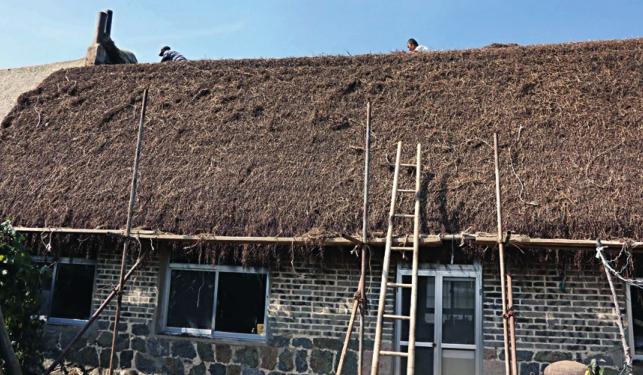Seaweed Bungalows
By GUO ZHIDONG


IN the coastal areas of Weihai, Yantai, and Qingdao in the Jiaodong Peninsula of east Chinas Shandong Province, there are many residential buildings that share a unique design. The roofs are made of a light brown and grayish white local kelp, and local residents call the houses seaweed bungalows or kelp houses.
These houses are one of the most representative ecological dwellings in the world and have a long history. Covering house roofs with plants was a common practice of construction in ancient times. Since that time, the seaboard of the Jiaodong Peninsula has been rich in wild kelp. Local residents gather and dry kelp to use as raw materials for building houses. According to research, the history of kelp houses can be traced back to the Neolithic Age, but the houses at that time were not really folk houses. After the Qin and Han dynasties (221 BC-AD 220), the structure of the kelp house gradually matured and was widely adopted. During the Ming and Qing dynasties (1368-1911), coastal defense was consolidated, and the population in coastal areas increased. Consequently, building kelp houses became a very common practice. In the 1970s and 1980s, with the introduction of new forms of living and concepts of life, the building materials of the houses gradually changed.
The plant used to thatch the house are mainly a kind of broad-leaved seaweed that grows in the shallow sea area. The seaweed becomes very flexible after it has been dried. Local residents use seaweed harvested in winter and spring as building materials, because seaweed during these seasons is stronger and more durable. The seaweed also has the merits of being rich in colloid, resistant to insects and mildew, and non-flammable, making it the preferred building material for the region. In addition, when covering the roof, grass and wheat straw are also used to match the seaweed.
Kelp is the material used to cover the roof, and the material for building the walls of the house is stone. The walls are made of large pieces of stone, which consequently do not create an orderly square design. Therefore, the gaps between the stones in the wall also form irregular lines, giving it a special charm. Some families will engrave a variety of decorative patterns on these stones, instilling the whole building with a bit of elegance and exquisiteness amidst the rugged appearance. Since the 1970s, the practice of using stones to make walls for seaweed bungalows has gradually changed to using bricks.
Seaweed bungalows are built with a U-shape or quadrangle dwelling design. Due to the hilly terrain, local residents have limited choices when select-ing the site of their house. Therefore, the size of the house is generally small, and each courtyard is located closely to that of the adjacent residence.
Due to the fact that the coastal area is rich in rainfall, roofs of local houses are all designed with herringbone slope pattern, with the gradient being about 50 degrees, and relatively high ridges. The highest point reaches up to four meters, which makes it easy for rainwater to flow down along the steep slope of the roof. This design can also alleviate the pressure of the winter snow on the roof. Since the roof area is larger, more kelp is needed to make it. The amount of seaweed used to build a house can exceed 5,000 kilograms.
The most important step in the construction of seaweed bungalows is covering the roof. This step also exhibits the characteristics of this kind of folk dwelling. The whole process is completed by hand and requires skill. Workers must pick out mature seaweed that is uniform in shape and size, straighten them out and tie them up, and then cover them up layer by layer. In order to serve the purpose of keeping the residence well insulated and sun-protected, the roof must be thick. Houses built in the past were covered by alternating layers of straw and seaweed, making the house warm in winter and cool in summer. The houses service lifespan depends mainly on how tightly the seaweed is arranged. To complete the process of covering a house roof, it usually takes a craftsman more than a month of hard work. In order to prevent the wind from blowing the seaweed off the roof, some residents also place a layer of worn fishing nets over the top of the roof, and use small pieces of heavy objects as pendants to stabilize the corners, thus making a house design that is rich in fishermens characteristics.
The houses are a symbol of the rich and colorful regional culture and customs. Before the construction, a day of good luck should be selected to begin the work. While building the wall base, objects symbolizing shoe-shaped ingots are placed in the four corners of the foundation to express the peoples good wishes for pursuing prosperity and good fortune. On this day, the host also makes dumplings to entertain guests and workers, because the dumplings resemble shoe-shaped ingots and represent auspiciousness and a spirit of celebration. After the completion of the house, a series of folk activities such as offering sacrifices, pasting papercuts on windows, and hanging curtains are held, all of which showcase the strong local customs.
Seaweed bungalows embody the ingenuity of coastal residents in adapting to the local natural environment, making it one of the most representative ecological houses in the world. It also symbolizes local history, culture, and folk customs, and has become the most unique architectural style in the Jiaodong area.

